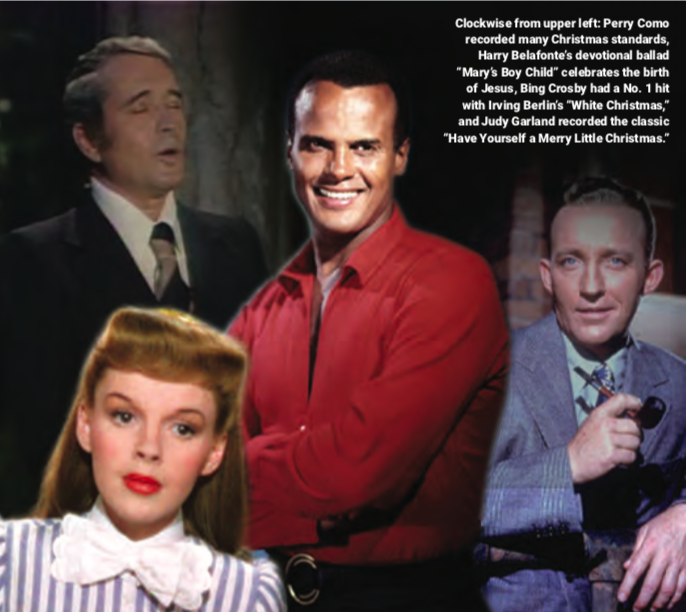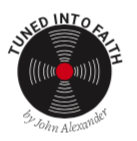
The ‘Old Chestnuts’ still stand the test of time during the holiday season
There is nothing more welcome than a Christmas song to put us in the mood for all the joyous blessings that celebrate the birth of baby Jesus. We look forward to enjoying these warm and familiar favorites, both religious and secular, that remind us about what really matters most — the love of family, enduring friendships and our faith in the Lord.
Since the turn of the last century, the music charts have been ranking the most popular songs of the season. Billboard magazine began tabulating the best-selling and most popular songs in 1890.
The first Christmas song to appear on the chart was “Toyland,” from the Broadway musical “Babes in Toyland.” It wrisas a No. 1 hit in 1904 as performed by The Haydn Quartet. One year later “Silent Night, Hallowed Night,” also performed by The Haydn Quartet, became the first religious song to appear on the chart.
 The German hymn “Silent Night,” composed in 1818 by Franz Xavier Gruber and Joseph Mohr, would go on to become one of the most popular Christmas hymns. It has been recorded by hundreds of artists since, including a No. 6 charting hit by Ernestine Schumann-Heink in 1908 that was performed in German under its original title, “Stille Nacht, Heilige Nacht.” Bing Crosby charted twice in the Top-10 with his version of “Silent Night” in 1936 and 1938. Since then, the song has become a perennial standard that’s included on almost every Christmas album by artists in every genre of music.
The German hymn “Silent Night,” composed in 1818 by Franz Xavier Gruber and Joseph Mohr, would go on to become one of the most popular Christmas hymns. It has been recorded by hundreds of artists since, including a No. 6 charting hit by Ernestine Schumann-Heink in 1908 that was performed in German under its original title, “Stille Nacht, Heilige Nacht.” Bing Crosby charted twice in the Top-10 with his version of “Silent Night” in 1936 and 1938. Since then, the song has become a perennial standard that’s included on almost every Christmas album by artists in every genre of music.
The popular vocal group Peerless Quartet made the pop chart in 1905 with their recording of the 18th century hymn “O Come, All Ye Faithful (Adeste Fideles).” Peerless Quartet reached No. 5 on the chart with their version, while popular Irish tenor John McCormack took it to No. 2 in 1915. It’s another bona fide classic; no Christmas concert or album would be complete without it.
Also making their first appearances on the chart at the turn of the last century are songs like “Auld Lang Syne,” about cherished memories of days gone by, and the devotional Catholic hymn “Ave Maria.” Based on an 18th century Scottish poem, “Auld Lang Syne” has become a New Year’s Eve anthem and was originally a No. 2 hit for Frank Stanley in 1907. It was also recorded by Peerless Quartet in 1921 and achieved its greatest fame when Guy Lombardo & His Royal Canadians first performed it in 1929 at the Roosevelt Hotel in New York. Lombardo’s performance was broadcast nationally from 1929 to 1976 and has become a New Year’s Eve staple.
“Ave Maria” first charted as a Top-10 song by Frances Alda in 1910. Possibly the most popular recording of the Catholic prayer composed by Franz Schubert was by Perry Como, who reached No. 22 with his single in 1949. The devoutly Catholic Como further popularized the “Hail Mary” hymn by performing it on his television variety show.
“Joy to the World,” an English Christmas carol dating back to 1719, announces the coming of the Lord by imploring every heart to “prepare Him room.” This classic made its first appearance on the music chart in 1911, featuring the Trinity Choir.
“Hark! The Herald Angels Sing” is yet another devotional ballad; it first appeared on the music chart in 1916. The Columbia Mixed Quartet reached No. 2 with the 18th century hymn celebrating the birth of our Lord. The song is still as popular today as it was more than 100 years ago, with its fervent prayer-like lyrics offering “Glory to the newborn King! Peace on earth and mercy mild, God and sinners reconciled.”
The biggest seasonal song of the 1930s was “Winter Wonderland,” by Guy Lombardo & His Royal Canadians. It climbed to No. 2 in 1934. Written that same year by Felix Bernard and Richard Bernhard Smith, it has since charted for artists including Perry Como, who took it to No. 10 in 1946 and charted again with it in 1952. The Andrews Sisters’ single reached No. 22, and Johnny Mercer made it to No. 4 in 1947.
While New York bandleader George Hall first charted with “Santa Claus is Comin’ to Town,” it was Bing Crosby and The Andrews Sisters who helped convert that secular ditty into a seasonal favorite.
“Jingle Bells” first charted in an instrumental version by big band leader Benny Goodman in 1935. Goodman’s made it to No. 18 while fellow bandleader Glenn Miller’s vocal cover made it to No. 5 in 1941. The 19th century favorite was composed by James Pierpont and originally published under the title “One Horse Open Sleigh” in 1857 as a Thanksgiving song. Bing Crosby and The Andrews Sisters had a Top-20 hit with the song in 1943 and 1947, respectively, while guitar legend Les Paul’s version made it to the Top-10 in 1952.
One song eclipsed all others during the 1940s, and that was Irving Berlin’s nostalgic ballad “White Christmas.” And it was Irish-Catholic crooner Bing Crosby who owned it then, and still owns it now. Crosby first reached No. 1 with the song in 1942, No. 5 in 1944 and No. 1 again in 1945. All in all, Crosby charted 21 times over the years with what remains his all-time signature song. Not to be outdone, fellow Catholic crooner legend Frank Sinatra’s cover of “White Christmas” made it to No. 7 in 1944 and No. 5 in 1946. The song was so popular that two of the most iconic artists of the 20th century could chart with it at the same time.
Crosby continued his Christmas streak of standards with the poignant “I’ll Be Home For Christmas (If Only in My Dreams),” a No. 3 hit for him in 1943.
Another standard introduced during the 1940s can be heard in a number of variations. When Judy Garland first heard Ralph Blane and Hugh Martin’s “Have Yourself a Merry Little Christmas,” she felt the lyrics were too depressing, with the original lyric reading, “Have yourself a merry little Christmas / It may be your last/ Next year we may all be living in the past.” The song’s lyric was changed and it was featured in the 1944 film “Meet Me in St. Louis,” and ultimately made it to No. 22 on the pop chart that same year.
When Frank Sinatra wanted to record the song, he still thought the revised lyric was too dismal and objected to the “Someday soon we all will be together, if the fates allow/ Until then we’ll muddle through somehow.” The lyric was changed for him to “Through the years we all will be together if the fates allow / Hang a shining star upon the highest bough and have yourself a merry little Christmas now.”
Fresh off his first No. 1 hit “(I Love You) For Sentimental Reasons,” former jazz pianist Nat King Cole reached No. 3 with “The Christmas Song” in 1946. The song, composed by fellow jazz crooner Mel Torme and Robert Wells and subtitled “Merry Christmas to You,” opens with the warm and inviting line, “Chestnuts roasting on an open fire.” The song embraces the wonder that appeals to “kids from one to 92.” The title couldn’t be more appropriate and it has become forever identified with Cole, who remains one of the most beloved pop vocalists of the 20th century.
Western cowboy star Gene Autry enjoyed a number of charting Christmas hits during the 1940s and 1950s, including the light-hearted “Here Comes Santa Claus (Down Santa Claus Lane),” a Top-10 hit in 1947 and 1948; “Rudolph the Red-Nosed Reindeer,” a No. 1 hit in 1949; “Frosty the Snowman,” a No. 7 hit in 1950 and “The Night Before Christmas Song,” a Top-10 duet with Rosemary Clooney in 1952.
Novelty Christmas hits ruled the 1950s, bracketed by two No. 1 hits – “I Saw Mommy Kissing Santa Claus” from 1952 by Jimmy Boyd, and “The Chipmunk Song (Christmas Don’t Be Late),” by David Seville with Alvin & The Chipmunks in 1959. Other highlights from the decade include actor and singer Dennis Day’s Top-10 Irish holiday standard “Christmas in Killarney,” Eartha Kitt’s provocative Top-5 hit “Santa Baby,” and Perry Como’s heartfelt No. 8 entry “(There’s) No Place Like Home for the Holidays.”
But the 1950s also introduced a number of religious standards, such as Harry Belafonte’s tender “Mary’s Boy Child,” about the birth of Christ on Christmas Day and “The Little Drummer Boy” by The Harry Simeone Chorale. That touching story song tells about a poor young drummer boy who wants to bestow a gift upon the baby Jesus and decides all he can offer is to play for Him on his drum. The song has held up over the years and was further popularized by country legend Johnny Cash, who released his well-received cover of the song in 1959.
With rock ’n’ roll emerging during the mid-50s, Bobby Helms scored one of the biggest hits of the decade with “Jingle Bell Rock,” a song that can still be heard today in its original form.
These are just some of the standards that emerged from the first half of the 20th century. The 60s, 70s, 80s, and 90s, right up to the present, have produced even more Christmas classics. In fact, the 60s kicked off with one of the top-ranked Christmas songs of all-time, Brenda Lee’s “Rockin’ Around the Christmas Tree.” But that’s another song for another story.
So as Harry Belafonte sang, “A long time ago in Bethlehem, so the Holy Bible say / Mary’s boy child Jesus Christ was born on Christmas Day…” As Perry Como so aptly reminded us, no matter where you may roam this holiday season, here’s wishing you a medley of family, friends, and memories to last a lifetime. Merry Christmas!
